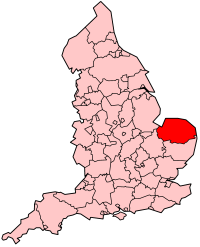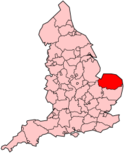Gresham’s School
| Gresham’s School | |
|---|---|
(c) Evelyn Simak, CC BY-SA 2.0 | |
| Die Schulbibliothek | |
| Schulform | Public School |
| Gründung | 1555 |
| Adresse | Cromer Road |
| Ort | Holt, Norfolk |
| County | Norfolk |
| Staat | Vereinigtes Königreich |
| Koordinaten | 52° 54′ 36″ N, 1° 6′ 13″ O |
| Schüler | etwa 760 |
| Lehrkräfte | etwa 90 |
| Leitung | Douglas Robb |
| Website | www.greshams.com |
Die Gresham’s School ist eine traditionsreiche Privatschule (Public School) für etwa 760 Jungen und Mädchen im Alter von 8 bis 18 Jahren in der Grafschaft Norfolk im Osten Englands. Die Schule wird durch Schulgebühren und Spenden finanziert. Die Schulgebühren gehören mit rund 36.000 GBP pro Schuljahr zu den höchsten Englands.
Die Schule zählt akademisch zu den renommiertesten Schulen Großbritanniens. Sie wurde 1555 von Sir John Gresham (1495–1556), dem damaligen Lord Mayor von London, als Wohltätigkeitsschule gegründet und diente dem Zweck, vierzig armen Schülern eine kostenlose Schulausbildung zu ermöglichen. Diese Stipendiaten gibt es nach wie vor als Holt Scholars. Ehemalige Schüler (Alumni) werden Old Greshamians genannt.

Ausbildung
Die stark humanistisch orientierte Ausbildung umfasst Fächer wie Sprachen (unter anderem Latein, Altgriechisch, Französisch, Russisch, Spanisch, Deutsch, Japanisch), Klassische Studien, Geschichte, Wissenschaft (Physik, Chemie, Biologie, Mathematik), Design Technologie, Literatur, Kunst/Kunstgeschichte, Drama/Theaterwissenschaft, Wirtschaft/Handel, Musik und Religiöse Studien.
Klassensystem
Die Schule benutzt die traditionelle englische Zählweise für Schuljahre. Es gibt die Klassen 3 bis 5 und die Sixth-Form, die sich aus der unteren Sixth-Form (Lower Sixth) und der oberen Sixth-Form (Upper Sixth) zusammensetzt. Dies entspricht den Klassen 6 bis 12 in Deutschland.
Häuser

Die Schule wird von den meisten Schülern als boarding school (Internat) genutzt. Die Schüler leben (wie an englischen Privatschulen üblich) in sieben Häusern (Boarding Houses). Zwischen diesen Häusern werden unter anderem Sportwettkämpfe ausgetragen.
Heute umfasst die Schule folgende Häuser:
- Howson’s (1903)
- Woodlands (1905)
- Farfield (1911)
- Tallis (1961)
- Oakeley (1971)
- Edinburgh (1984)
- Britten (1992)
Bekannte Schüler
- W. H. Auden (1907–1973), Dichter, Schriftsteller
- Richard Austin (1903–1989), Dirigent
- Arthur Christopher Benson (1862–1925), Schriftsteller
- Lennox Berkeley (1903–1989), Komponist
- Eric Berthoud (1900–1989), Industrieller und Diplomat
- Tom Bourdillon (1924–1956), Bergsteiger
- Robert Bray (1908–1983), General der British Army
- Peter Brook (1925–2022), Theaterregisseur
- Benjamin Britten, Baron Britten (1913–1976), Komponist, Dirigent und Pianist
- Martin Burgess (1931–2022), Uhrmacher
- Erskine Childers (1905–1974), Präsident von Irland
- Sir Christopher Cockerell (1910–1999), Ingenieur und Erfinder des Hovercrafts
- Norman Cohn (1915–2007), Historiker
- Weldon Dalrymple-Champneys (1892–1980), Arzt im öffentlichen Gesundheitswesen
- Antony Copley (1937–2016), Historiker
- John Daly (1901–1985), anglikanischer Bischof in Afrika und Asien
- Henry Daniell (1894–1963), Schauspieler
- James Dyson (* 1947), Erfinder und Unternehmer
- Ralph Firman (* 1975), Rennfahrer
- Stephen Frears (* 1941), Filmregisseur
- Stephen Fry (* 1957), Schauspieler und Regisseur
- Sienna Guillory (* 1975), Filmschauspielerin, Produzentin und Model
- Sir Alan Lloyd Hodgkin (1914–1998), Biochemiker mit dem Nobelpreis geehrt
- George Evelyn Hutchinson (1903–1991), Limnologe und Ökologe
- David Kenworthy (1914–2010), Politiker
- David Lack (1910–1973), Biologe und Ornithologe
- Donald Maclean (1913–1983), Geheimagent und Mitglied der Cambridge Five
- Michael Lindsay (1909–1994), Peer
- Ben Nicholson (1894–1982), Maler und Objektkünstler
- Miranda Raison (* 1977), Schauspielerin
- John Reith (1889–1971), Gründervater und erster Generaldirektor der BBC
- Wilfrid Roberts (1900–1991), Politiker
- Sebastian Shaw (1905–1994), Schauspieler, Theaterregisseur, Dichter
- Jocelyn Simon (1911–2006), Peer und Lordrichter
- Stephen Spender (1909–1995), Dichter
- Christopher Strachey (1916–1975), Informatiker
- Pat Symonds (* 1953), Chefingenieur bei Renault F1
- John Tusa (* 1936), Rundfunk- und Fernsehjournalist
- Paul Wilson (1908–1980), Hydraulikingenieur und Politiker
- Robin Woods (1914–1997), Geistlicher und Mitglied des House of Lords
- Percy Wyn-Harris (1903–1979), Bergsteiger, Gouverneur in der britischen Kolonie Gambia
Weblinks
Auf dieser Seite verwendete Medien
(c) Evelyn Simak, CC BY-SA 2.0
Entrance to Gresham's Senior School, founded in 1555 by Sir John Gresham, who converted Holt's Manor House into a Free Grammar School as a result of Henry VIIIs suppression of the Monasteries. It survived the Great Fire of 1708 which destroyed most of medieval Holt and was extensively enlarged and refurbished in Victorian times. At the turn of the twentieth century, Gresham's was refounded under the direction of a new and innovative headmaster, George Howson and the School moved to the existing site (gate pictured). The Senior School and Prep School are presently located along both sides of Cromer Road on the eastern edge of Holt. There are four boarding houses for boys and three for girls and a wide range of buildings which include Big School, the School Chapel, the Auden Theatre, the Cairns Centre, the School Library, the Music Centre, the Central Block, the Thatched Classrooms, the Reith Laboratories, the Biology Building, the Armoury, and others. In September 2005, Gresham's was one of the leading British schools. http://www.greshams.com/history.php
(c) Evelyn Simak, CC BY-SA 2.0
Gresham's School One of the school buildings on Cromer Road. The school was founded in 1555 by Sir John Gresham, who converted Holts Manor House into a Free Grammar School as a result of Henry VIIIs suppression of the Monasteries. It survived the Great Fire of 1708 which destroyed most of medieval Holt and was extensively enlarged and refurbished in Victorian times. Renamed Old School House it currently serves as home to the Pre-Prep School. At the turn of the twentieth century, Greshams was refounded under the direction of a new and innovative headmaster, George Howson and the School moved to the existing site. The Senior School and Prep School are presently located along both sides of Cromer Road on the eastern edge of Holt. There are four boarding houses for boys and three for girls and a wide range of buildings which include Big School, the School Chapel, the Auden Theatre, the Cairns Centre, the School Library, the Music Centre, the Central Block, the Thatched Classrooms, the Reith Laboratories, the Biology Building, the Armoury, and others. In September 2005, Gresham's was one of the leading British schools. http://www.greshams.com/history.php
Gresham grasshopper
Illustration of Gresham's School, Holt, from John William Burgon's The Life and Times of Sir Thomas Gresham (1839) "from a sketch made on the spot in 1838" (detail).





